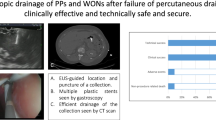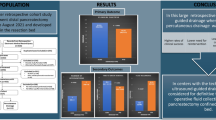Abstract
Purpose
Postoperative pancreatic fistula (POPF) after pancreatectomy is one of the severe postoperative adverse events. We aimed to clarify the outcomes of a strategy for POPF after left-sided pancreatectomy with one-step endoscopic ultrasonography-guided drainage (EUSD) and percutaneous drainage (PCD) based on the wall status of collected fluid.
Methods
From January 2012 to September 2017, 90 of 336 patients developed grade B/C POPF and were retrospectively analyzed. Primary outcome measures were the technical and clinical success and resolution rates. Secondary outcome measures were time from surgery to intervention, and time from intervention to discharge/resolution or stent/tube removal and adverse events.
Results
Seventeen patients underwent EUSD and 73 patients underwent PCD for POPF. The technical success rates were 100% in both the EUSD and PCD groups. The clinical success and resolution rates in the EUSD group were 100%, while those in the PCD group were 98.6%. The time from surgery to intervention was significantly longer in the EUSD group than in the PCD group (20 vs. 11 days, p < 0.001). The time from intervention to discharge/resolution was significantly shorter in the EUSD group than in the PCD group (11 vs. 22 days, p < 0.001/10 vs. 20 days, p < 0.001). The time from intervention to stent/tube removal was significantly shorter in the PCD group than in the EUSD group (20.5 vs. 873 days, p < 0.001). Adverse event rates were similar in the two groups (11.8% vs. 5.5%).
Conclusion
A drainage strategy for POPF based on the wall status of collected fluid is appropriate.







Similar content being viewed by others
References
Bassi C, Marchegiani G, Dervenis C, Sarr M, Abu Hilal M, Adham M, Allen P, Andersson R, Asbun HJ, Besselink MG, Conlon K, del Chiaro M, Falconi M, Fernandez-Cruz L, Fernandez-del Castillo C, Fingerhut A, Friess H, Gouma DJ, Hackert T, Izbicki J, Lillemoe KD, Neoptolemos JP, Olah A, Schulick R, Shrikhande SV, Takada T, Takaori K, Traverso W, Vollmer CR, Wolfgang CL, Yeo CJ, Salvia R, Buchler M, International Study Group on Pancreatic Surgery (ISGPS) (2017) The 2016 update of the International Study Group (ISGPS) definition and grading of postoperative pancreatic fistula: 11 years after. Surgery 161:584–591
Kitahata Y, Kawai M, Yamaue H (2016) Clinical trials to reduce pancreatic fistula after pancreatic surgery-review of randomized controlled trials. Transl Gastroenterol Hepatol 1:4
Smits FJ, van Santvoort HC, Besselink MG, Dutch Pancreatic Cancer Group et al (2017) Management of severe pancreatic fistula after pancreatoduodenectomy. JAMA Surg 152:540–548
Rangelova E, Valente R, Del Chiaro M (2017) “Step-up approach” for the treatment of postoperative severe pancreatic fistula: is it really possible and useful? JAMA Surg 152:548–549
Tamura T, Kitano M, Kawai M et al (2019) Effectiveness of endoscopic ultrasound-guided drainage for noncapsulated postoperative pancreatic collection. Ther Adv Gastroenterol 12:1756284819884418
Jürgensen C, Distler M, Arlt A, Brückner S, Ellrichmann M, Matthes K, Ludwig M, Sulk S, Romberg L, Zeissig S, Schafmayer C, Hinz S, Welsch T, Bahra M, Aselmann H, Weitz J, Klein F, Becker T, Hampe J (2019) EUS-guided drainage in the management of postoperative pancreatic leaks and fistulas. Gastrointest Endosc 89:311–319
Bellam BL, Samanta J, Gupta P, Kumar M P, Sharma V, Dhaka N, Sarma P, Muktesh G, Gupta V, Sinha SK, Kochhar R (2019) Predictors of outcome of percutaneous catheter drainage in patients with acute pancreatitis having acute fluid collection and development of a predictive model. Pancreatology 19:658–664
Denzer UW, Sioulas AD, Abdulkarim M et al (2016) Endoscopic ultrasound-guided drainage of abdominal fluid collections after pancreatic surgery: efficacy and long-term follow-up. Z Gastroenterol 54:1047–1053
Arvanitakis M, Delhaye M, Bali MA, Matos C, de Maertelaer V, le Moine O, Devière J (2007) Pancreatic fluid collections: a randomized controlled trial regarding stent removal after endoscopic transmural drainage. Gastrointest Endosc 65:609–619
Chandran S, Efthymiou M, Kaffes A, Chen JW, Kwan V, Murray M, Williams D, Nguyen NQ, Tam W, Welch C, Chong A, Gupta S, Devereaux B, Tagkalidis P, Parker F, Vaughan R (2015) Management of pancreatic collections with a novel endoscopically placed fully covered self-expandable metal stent: a national experience. Gastrointest Endosc 81:127–135
Seewald S, Ang TL, Richter H et al (2012) Long-term results after endoscopic drainage and necrosectomy of symptomatic pancreatic fluid collections. Dig Endosc 24:36–41
Vazquez-Sequeiros E, Baron TH, Pérez-Miranda M, Sánchez-Yagüe A, Gornals J, Gonzalez-Huix F, de la Serna C, Gonzalez Martin JA, Gimeno-Garcia AZ, Marra-Lopez C, Castellot A, Alberca F, Fernandez-Urien I, Aparicio JR, Legaz ML, Sendino O, Loras C, Subtil JC, Nerin J, Perez-Carreras M, Diaz-Tasende J, Perez G, Repiso A, Vilella A, Dolz C, Alvarez A, Rodriguez S, Esteban JM, Juzgado D, Albillos A (2016) Evaluation of the short- and long-term effectiveness and safety of fully covered self-expandable metal stents for drainage of pancreatic fluid collections: results of a Spanish nationwide registry. Gastrointest Endosc 84:450–457
Wang Z, Zhao S, Meng Q, Wang S, Chen Y, Wang F, Li Q, Yao J, du Y, Jin Z, Bai Y, Li Z, Wang D (2019) Comparison of three different stents for endoscopic ultrasound-guided drainage of pancreatic fluid collection: A large retrospective study. J Gastroenterol Hepatol 34:791–798
Azeem N, Baron TH, Topazian MD, Zhong N, Fleming CJ, Kendrick ML (2012) Outcomes of endoscopic and percutaneous drainage of pancreatic fluid collections arising after pancreatic tail resection. J Am Coll Surg 215:177–185
Acknowledgments
We deeply appreciate the support provided by Dr. Shin Kato, Dr. Koji Hirata, Dr. Hajime Hirata, Dr. Ryo Sugiura, Dr. Ryutaro Furukawa, Dr. Yunosuke Takishin, Dr. Naoya Sakamoto, Dr. Takahiro Tsuchikawa, Dr. Kimitaka Tanaka, Dr. Yoshitsugu Nakanishi, and Dr. Tomohide Nakayama from Hokkaido University Hospital; Dr. Kazuma Ishikawa, Dr. Yuki Ikeda, Dr. Yoshiharu Masaki, Dr. Ayako Ito, and Dr. Minoru Nagayama from Sapporo Medical University; Dr. Kei Yane, Dr. Toshifumi Kin, Dr. Kazunari Tanaka, Dr. Koki Chikugo, Dr. Shunsuke Honda, Dr. Haruka Toyonaga, Dr. Hidetaro Ueki, Dr. Yoshiyasu Anbo, Dr. Minoru Takada, and Dr. Kentaro Kato from Teine Keijinkai Hospital.
Hokkaido Pancreatic Cancer Study Group: HOPS—Masaki Kuwatani; Masafumi Imamura; Tsuyoshi Hayashi; Makoto Yoshida; Yasutoshi Kimura; Toshimichi Asano; Toru Nakamura; Masayo Motoya; Makoto Yoshida; Takehiro Noji; Keisuke Okamura; Kuniyuki Takahashi; Akio Katanuma; Satoshi Hirano.
Author information
Authors and Affiliations
Consortia
Contributions
M. Kuwatani, T. Hayashi, M. Yoshida, M. Motoya, T. Nakamura, Y. Kimura, T. Noji, K. Okamura, and K. Takahashi contributed to the study concept, design, and definition of intellectual content. M. Kuwatani contributed to the literature search, data analysis, and statistical analysis. M. Kuwatani, M. Imamura, T. Hayashi, M. Yoshida, and T. Asano contributed to data acquisition. M. Kuwatani, T. Hayashi, and Y. Kimura contributed to manuscript preparation and manuscript editing. A. Katanuma and S. Hirano contributed to manuscript review.
Corresponding author
Ethics declarations
Enrollment into this study was performed with informed consents of the patients or their families. In addition, this study was performed in accordance with the Declaration of Helsinki.
This manuscript has been read and approved by all the authors, and the requirements for authorship as stated in the document of instructions of the authors have been met.
Conflict of interest
The authors declare that they have no conflicts of interest.
Additional information
Publisher’s note
Springer Nature remains neutral with regard to jurisdictional claims in published maps and institutional affiliations.
Rights and permissions
About this article
Cite this article
Kuwatani, M., Imamura, M., Hayashi, T. et al. A drainage strategy for postoperative pancreatic fistula after left-sided pancreatectomy based on the wall status of collected fluid. Langenbecks Arch Surg 406, 743–751 (2021). https://doi.org/10.1007/s00423-020-02067-8
Received:
Accepted:
Published:
Issue Date:
DOI: https://doi.org/10.1007/s00423-020-02067-8




